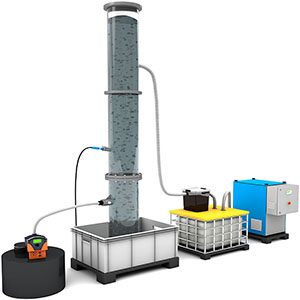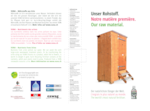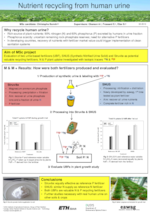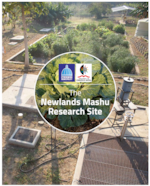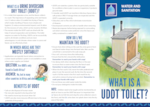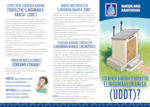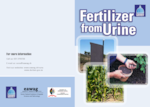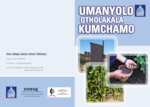Abteilung Verfahrenstechnik
VUNA-Projekt – Nährstoffrückgewinnung aus Urin
Willkommen auf der Website des Forschungsprojekts VUNA (2010-2015). Aus dem Projekt ist inzwischen das Eawag-Spin-Off Vuna GmbH entstanden: www.vuna.ch
Ziel des VUNA-Projekts war es Nährstoffe aus Urin zurückzugewinnen, mit einem Sanitärsystem, welches erschwinglich ist, wertvollen Dünger produziert, die Unternehmerschaft fördert und Gewässerverschmutzung reduziert.
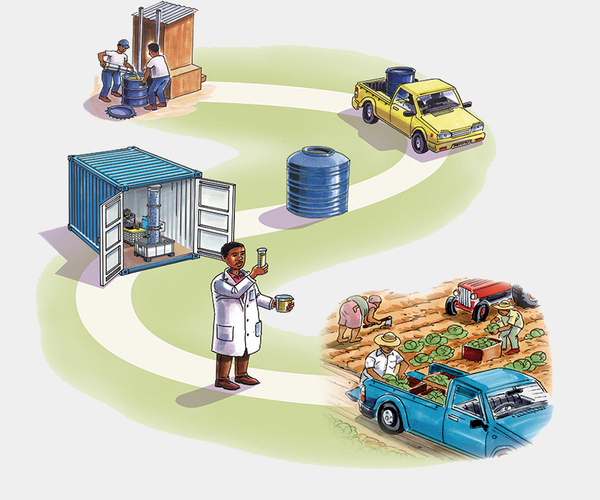
Forschung im VUNA-Projekt
Im VUNA-Projekt forschen wir zu folgenden Themen. Eine detaillierte Zusammenstellung der Resultate finden Sie im VUNA Abschlussbericht 2015.
Verfahren zur Nährstoffrückgewinnung aus Urin
Unser Körper scheidet den grossen Teil der Nährstoffe im Urin aus (nicht in den Fäkalien). Indem wir Urin separat sammeln, können wir wertvolle Nährstoffe wie Stickstoff, Phosphor, Kalium usw. zurückgewinnen. Gleichzeitig vermeiden wir, Gewässer mit hohen Nährstoffeinträgen zu verschmutzen.
VUNA Nährstoffrückgewinnung Pilotanlagen
Eawag Hauptgebäude:
Forum Chriesbach
eThekwini Municipality:
Customer Care Centre
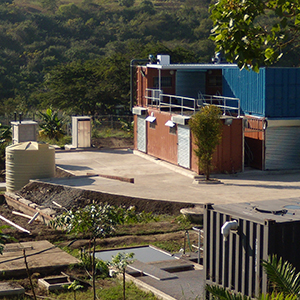
Feldversuchsanlage:
Newlands-Mashu
Risiken bei der Verwendung von Urin
Urine and Fertiliser Quality
The foremost goals of urine treatment are the recovery of nutrients for beneficial use. However, the urine treatment processes must also ensure that the end-products are safe to use, provide adequate human and environmental health protection, and are of adequate quality to ensure optimal market value. Pathogens and pharmaceuticals could potentially impact the quality of end products.
Research activities:
- Removing pharmaceuticals: The majority of pharmaceutical residues are excreted in the urine (and not the faeces). Hence, the separate collection of urine isolates pharmaceuticals and prevents them from entering the environment. Experiments showed that long-term storage is not sufficient to remove pharmaceuticals. Nevertheless, processes occurring during nitrification, are suitable to remove certain pharmaceuticals. Virtually all pharmaceuticals can be removed in an activated carbon filter.
- Inactivating pathogens: Whereas some pathogens can be excreted in the urine, others are introduced from cross-contamination with faeces during urine collection. We evaluated the viability of representative pathogens during urine treatment. We observed partial disinfection through urine storage and nitrification. Distillation is assumed to eliminate all pathogens due to high temperatures. Research partner: Environmental Chemistry Laboratory at EPFL.
Dünger aus Urin

Düngerversuche mit VUNA-Dünger
Partnerprojekte testeten VUNA-Dünger in Südafrika und in der Schweiz. Am UKZN Agricultural Engineering Department in Pietermaritzburg düngten AgrarwissenschaftlerInnen Mais mit Struvit, getrocknetem und granuliertem Fäkalschlamm und herkömmlichem Superphosphat.
An der ETH Zürich produzierte die Gruppe für Pflanzenernährung isotopen-markierten Struvit und Nitrifikations/Verdampfungs-Produkt. Die Versuche in den Gewächshäusern der ETH zeigten, dass Pflanzen Nährstoffe aus VUNA-Düngern gleich gut aufnehmen wie herkömmlichen Dünger.
2015 bewilligte das Bundesamt für Landwirtschaft (BLW) unsern:
Aurin Flüssigdünger
Urin-Sammelnetze
eThekwini Water and Sanitation introduced urine-diverting toilets as a system to supply sanitation to unserved regions, where water is scarce and water-borne sewer systems are too costly. Therefore a cost-efficient and optimised urine collection approach is necessary to harvest the valuable nutrients in urine.
Research activities:
- Optimising urine collection: We aim to make urine collection more cost efficient. Therefore, we implemented a pilot urine collection scheme to gain experiences and suggest improvements. Based on the evaluated costs, we are currently developing a business plan.
- Performance Modelling: The entire system of urine collection, transport and decentralised treatment consists of a large number of interconnected elements (e.g. toilets, storage tanks, treatment reactors) which influence the overall system performance (e.g. pollution control, urban hygiene, fertilizer production). Using a combination of system analysis and mathematical modelling we identified critical elements, evaluated the value of particular measurement schemes and estimated the overall system performance.
Soziale und wirtschaftliche Aspekte von Trenntoiletten
The success of any sanitation programme depends on people's willingness to accept it. Urine-diverting toilets are still not well accepted by many. In order to increase acceptance, health and hygiene education is needed.
Research activities:
- Social acceptance: We accompanied the introduction of the VUNA technologies with studies, which investigated the socio-cultural perceptions and factors influencing users’ acceptance.
- Campaigning for health & hyigene: Based on our findings from the acceptance studies, we developed appropriate educational activities and awareness material, e.g. for households and schools.
- Incentives for urine production: By giving urine a financial value, we tested how to increase toilet use, improve hygiene, reduce loss of valuable nutrients and augment household income for the poorest.
- Business model: To better understand the value chain from urine to fertiliser, we analysed the various components of the nutrient recovery system with a business perspective.
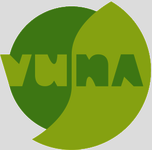
Über uns
Abkürzung, Name und Credo zugleich, steht das Wort VUNA für "Valorisation of Urine Nutrients in Africa" (Nährstoffverwertung aus Urin in Afrika) und ist der Name unseres Projektes. In IsiZulu, der Sprache des Projektstandortes in eThekwini, Südafrika, bedeutet "Vuna" Ernte. Eine gesunde Ernte folgt einer ausgeglichenen Düngerbilanz. Und, im Fall des Projektes VUNA, gewinnen oder "ernten" wir den nötigen Dünger aus Urin.
Projektteam
Steuerungsausschuss
Projektleiter
Projektkoordinator
Verfahren zur Nährstoffrückgewinnung
- Komplette Nährstoffrückgewinnung: Bastian Etter, Alexandra Fumasoli, Bettina Sterkele, Kai M. Udert, Lungiswa Zuma, Chris Buckley, Chris Brouckaert, Mlungisi Mthembu
- Nitrifikation: Alexandra Fumasoli, Bastian Etter, Bettina Sterkele, Kai M. Udert, Eberhard Morgenroth
- Verdampfung: Bastian Etter, Kai M. Udert
- Elektrolyse: Hanspeter Zöllig, Eberhard Morgenroth, Kai M. Udert
- Struvit: Lungiswa Zuma, Chris Buckley, Chris Brouckaert
- Prozesskontrolle: Kris Villez, Alma Mašić, Christian Thürlimann
Risiken bei der Verwendung von Urin
- Krankheitserreger: Loïc Decrey, Tamar Kohn, Heather Bischel
- Arzneimittelrückstände: Christa McArdell, Kai M. Udert
Landwirtschaft
- Düngerversuche: Astrid Oberson, Christophe Bonvin, Emmanuel Frossard, Simone Nanzer, Alfred Odindo, Irene Bame, William Musazura
Urin-Sammelnetze
- Urinsammlung: Teddy Gounden, Hope Joseph, Kevyn Govender, Scelo Xulu
- Modellierung: Max Maurer
Soziale und wirtschaftliche Aspekte
- Gesellschaftliche Akzeptanz: Lisa Frost Ramsay, Scelo Xulu
- Hygiene-Bildung: Nosipho Mkhize, Myra Taylor
- Finanzielle Anreize: Elizabeth Tilley, Isabel Günther
- Geschäftsmodell: Heiko Gebauer, Hope Joseph, Elena Friedrich
Bill & Melinda Gates Foundation
- Programme Officer: Carl Hensmann
Ehemalige Projekt-Mitarbeitende
- Komplette Nährstoffrückgewinnung: Michael Wächter, Mathias Mosberger, Maximilian Grau, Sara Rhoton
- Nitrifikation: Alexandra Florin, Corine Uhlmann, Gabriel Kämpf
- Verdampfung: Michael Wächter, Samuel Huber, Mischa Schwaninger, Thomas Gmeinwieser
- Elektrolyse: Christina Fritzsche, Annette Remmele, Anja Sutter
- Struvit: Maximilian Grau, Sara Rhoton, Merlien Reddy, Sibongile Maqubela, Mlungisi Mthembu, Samukelisiwe ‘Thandi’ Cele, Musawenkosi ‘Moussa’ Ndlovu
- Prozesskontrolle: Ana Santos, Lorenzo Garbani Marcantini, Angelika Hess, Elisabeth Grimon
- Arzneimittelrückstände: Birge D. Oezel Duygan, Annette Remmele
- Krankheitserreger: Manfred Schoger, Ariane Schertenleib, Sara Oppenheimer, Simon Schindelholz
- Urinsammlung: Peter Spohn, Lucky Sibiya
- Modellierung: Theresa Rossboth, Thomas Hug, Andreas Scheidegger
- Gesellschaftliche Akzeptanz: Elisa Roma, Marietjie Coertzen
- Finanzielle Anreize: Leeanne MacGregor
- Geschäftsmodell: Luzius Etter
- BMGF: Alyse Schrecongost
- Dokumentation: Corine Uhlmann, Nina Gubser, Susan Mercer
Dokumentation
Einen Überblick über das VUNA-Projekt erhalten Sie im VUNA Abschlussbericht 2015. Mehr Details erfahren Sie in den unten stehenden Zeitungsartikeln, Videos und Fachbeiträgen.
Videos
VUNA on YouTube
VUNA on TV
VUNA at the Faecal Sludge Management Conference 2012
Medienecho
Pour la revue de presse en langue française, veuillez visiter le site en français.
To see all media coverage in English language, visit our site in English.
Medienecho auf Deutsch
Naturschutz.ch: Dünger der Zukunft
Blick online: Urin-Recycling an der OLMA (Video)
St. Galler Tagblatt: 150 Flaschen Dünger verkauft
St. Galler Tagblatt: Urinrecycling im OLMA-Container
St. Galler Tagblatt: Die Urinverwertung wird zur Sonderschau
Radio 1: Flüssigdünger aus Urin (Radio)
3sat: Mit Urin gedüngt (Video)
toxic.fm: Blumendünger aus OLMA-Urin (Radio)
FM1 Today: OLMA-Urin wird zu Flüssigdünger (Radio)
St. Galler Tagblatt: Pflanzendünger aus OLMA-Urin (Radio)
20 Minuten: Urin der OLMA-Gänger wird zu Blumendünger
TVO: Kein Seich (Video)
Appenzeller Zeitung: Pflanzendünger aus OLMA-Urin
OE1: Phosphor - Versorgung sichern durch Recycling (Radio)
Geschäftsbericht 2014 ETH-Bereich: Pflanzen düngen statt Wasser verschmutzen
Technology Review: Geruchloser Dünger aus Urin
Deutschlandfunk: Dünger aus Urin
Aargauer Zeitung: Kein Mist, unser Pipi wird zu Dünger für unsere Blumenbeete
Radio Pilatus: Dünger aus Urin (Radio)
Spektrum der Wissenschaft: Urin - der Dünger der Zukunft?
Der Spiegel: Gold aus Gülle und Knochen
Tages-Anzeiger: Urin ist zu schade zum Runterspülen
Deutschlandfunk: Forschung aktuell - Dünger aus Urin (Radio)
Blick TV: Dieses WC macht aus Pipi Dünger (Video)
SF Tagesschau: Cleantec City für eine saubere Zukunft (Video)
Der Bund: Ausblick auf eine saubere Zukunft
NZZ am Sonntag: Die Zukunft liegt im Urin
Pressetext: Südafrika testet Verwertung von Urin
Basler Zeitung: Bill Gates finanziert Schweizer Projekt
Der Bund: Bill Gates finanziert Schweizer Projekt
Tages Anzeiger: Bill Gates finanziert Schweizer Projekt
myScience: Urin als Rohstoff der Zukunft?
nachhaltigkeit.org: Abwasserklärung mit Bill Gates
DRS 1: Urin bald als Dünger? (Radio)
Broschüren
Publikationen – Konferenzbeiträge (zum herunterladen)
VUNA im Allgemeinen
Verfahren zur Nährstoffrückgewinnung
Urin-Sammelnetze
Soziale und wirtschaftliche Aspekte
Publikationen – referenziert (mit Links zu RefWorks)
Verfahren zur Nährstoffrückgewinnung
Risiken bei der Verwendung von Urin
Landwirtschaft
Urin-Sammelnetze
Soziale und wirtschaftliche Aspekte
Publikationen – (noch) nicht referenziert
VUNA im Allgemeinen
- Udert, K.M., Etter, B., Gounden, T. (2016) Promoting Sanitation in South Africa through Nutrient Recovery from Urine. GAIA - Ecological Perspectives for Science and Society, 25(3), 194-196.
Verfahren zur Nährstoffrückgewinnung
- Fumasoli, A. (2016) Nitrification of urine as pretreatment for nutrient recovery. PhD thesis, ETH Zurich.
- Fumasoli, A., Weissbrodt, D., Wells, G.F., Bürgmann, H., Mohn, J., Morgenroth E., Udert K.M. (2015) Low pH selects for nitrosococcus in high and nitrosospira in low salt environments. In preparation.
- Grau, M.G.P., Rhoton, S., Brouckaert, C.J., Buckley, C.A. (2015) Development of a fully automated struvite reactor to recover phosphorus from source-separated urine collected at urine diversion toilets in eThekwini. Water SA, 41(3), 383-389.
- Grimon, E. (2015) Sensor characterization & monitoring for soft-sensing of urine nitrification systems. Master’s thesis, ETH Zurich.
- Hess, A. (2015) Feasibility of UV-Vis spectrophotometry for nitrite estimation in urine nitrification systems. Master’s thesis, ETH Zurich.
- Santos, A.T.L. (2014) Evaluation of UV spectrophotometry for estimation of nitrite and nitrate in nitrified urine. Master's thesis. Universidade Nova de Lisboa.
- Wächter, M., Huber, S., Kluge, J., Mazzotti, M., Udert, K.M. (2015) Selective crystallization of sodium chloride (NaCl) from partially nitrified urine. In preparation.
- Wächter, M., Schwaninger, M., Gmeinwieser, T., Udert K.M. (2015) Safety assessment for production and storage of nitrified and concentrated fertilizer from human urine. In preparation.
Risiken bei der Verwendung von Urin
- Bischel, H.N., Schindelholz, S., Schoger, M., Decrey, L., Bosshard, F., Udert, K.M., Kohn, T. (2015) Bacteria inactivation during drying of struvite fertilizers produced from stored urine. In preparation.
- Decrey, L., Kohn, T. (2017) Virus inactivation in stored human urine, sludge and animal manure under typical conditions of storage or mesophilic anaerobic digestion. Environmental Science: Water Research & Technology, DOI: 10.1039/c6ew00311g
- Decrey, L., Kazama, S., Kohn, T. (2016) Ammonia as an In Situ Sanitizer: Influence of Virus Genome Type on Inactivation. Applied Environmental Microbiology, 82, 4909–4920.
- Decrey, L. (2015) Virus inactivation in human excreta and animal manure. PhD thesis, EPF Lausanne.
- Oezel Duygan, B.D., Udert, K.M., Remmele, A., McArdell, C.S. (2015) Fate of pharmaceuticals in source-separated urine during storage, biological treatment and powdered activated carbon adsorption. In preparation.
- Oezel, B.D. (2013) Fate of pharmaceuticals during urine treatment in laboratory batch experiments: can urine be used as fertilizer in South Africa? Master’s thesis, ETH Zurich.
- Schertenleib, A. (2014) Inactivation of pathogens in urine nitrification reactors. Master’s thesis, EPF Lausanne.
- Schoger, M. (2011) Bacterial inactivation in struvite recovered from urine in South Africa. Master’s thesis, EPF Lausanne.
Landwirtschaft
- Bonvin, C. (2013) Recycling of phosphorus & nitrogen from human urine: evaluation of urine based fertilizers in a pot experiment. Master’s thesis, ETH Zurich.
Urin-Sammelnetze
- Joseph, H.R. (2015) Develop and describe a suitable logistic collection system for urine harvesting in eThekwini. Master’s thesis, University of KwaZulu-Natal. In preparation.
- Rossboth,T., Udert, K.M., Maurer, M. (2015) Using stochastic modelling to support urine collection scheme planning in South Africa. In preparation.
Soziale und wirtschaftliche Aspekte
- Etter, B., Etter, L., Joseph, H.R., Grau, M.G.P., Chetty, S., Gounden, T., Gebauer, H., Udert, K.M. (2015) Financial opportunities for complete nutrient recovery from source-separated urine in eThekwini, South Africa. In preparation.
- Mkhize, N. (2015) The role of health & hygiene education in the accept- ance, utilisation, and maintenance of urine diversion toilets in rural communities of KwaZulu-Natal (preliminary title). Master’s thesis, University of KwaZulu-Natal. In preparation.
- Mkhize, N., Taylor, M., Udert, K.M., Gounden, T., Buckley C.A. (2017) Urine diversion dry toilets in eThekwini Municipality, South Africa: Acceptance, use and maintenance: through users eyes. Water, Sanitation and Hygiene for Development, in press.
- Okem, A.E., Xulu, S., Tilley, E., Buckley, C., Roma E. (2013) Assessing perceptions and willingness to use urine in agriculture: a case study from rural areas of eThekwini municipality, South Africa. Journal of Water Sanitation and Hygiene for Development 3(4), 582-591.
- Ramsay, L.F., Coertzen, M., Buckley, C.A., Gounden, T. (2015) The power of perception: views and practices related to urine diversion toilets in the eThekwini Municipality, South Africa. In preparation.
- Roma, E., Philp, K., Buckley, C., Xulu, S., Scott, D. (2013) User percep- tions of urine diversion dehydration toilets: Experiences from a cross- sectional study in eThekwini Municipality. Water SA 39(2), 305-312.
- Tilley, E., Günther, I. (2016) The Impact of Conditional Cash Transfer on Toilet Use in eThekwini, South Africa. Sustainability 2016, 8(10), 1070
- Tilley, E. (2015) Acceptance, impact & feasibility of incentives for increasing toilet use: a case study in eThekwini, South Africa. PhD Thesis, ETHZ.

